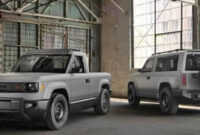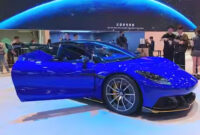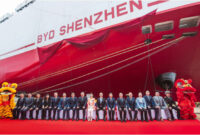A prototype of what appears to be Tesla’s forthcoming robotaxi has been noticed by a Reddit user who claims to work at Warner Bros. studio in Los Angeles, where the unveiling of the so-called “Cybercab” is expected to occur on October 10.
The vivid yellow prototype shown in the attached photo seems to be a heavily disguised two-door model with headlights reminiscent of the Model 3. According to the user Boopitysmopp, who shared the image, the vehicle also features a full-width LED light strip at the back similar to the Cybertruck’s.
The entire design resembles a life-size Matchbox car, and it could simply be a poor joke, so we’re approaching this with caution. However, considering the location, the shape of the side windows, and the car’s short wheelbase together, we have reason to believe this could be Tesla’s long-anticipated self-driving cab.
Recently, Musk has shifted his focus from presenting Tesla solely as an all-electric vehicle manufacturer to discussing artificial intelligence and robotics, hinting for some time that Tesla EVs—both existing and new—could soon integrate into a global system of autonomous vehicles that transports people independently for the benefit of their owners.
Consequently, the upcoming Cybercab holds significant importance for Tesla’s vocal CEO. Could it be the major breakthrough that Musk has predicted? We remain doubtful. The company’s Autopilot and Full Self-Driving (Supervised) features are still classified as Level 2 systems on SAE’s autonomy chart. Additionally, the existing legal framework does not permit fully autonomous vehicles to operate freely on the streets and highways of the United States, indicating that more work is necessary.
That said, Tesla aims to ensure everything proceeds smoothly during next month’s event. Following a slowdown in global sales, the automaker—sorry, AI and robotics company—has been collecting mapping data from the area where the event is set to occur, according to Bloomberg and renowned Tesla hacker Green The Only.
This strategy makes sense from a performance perspective, but it contradicts many of Musk’s statements on autonomous vehicles, as he has criticized competing automakers and robotaxi services for relying on pre-existing map data to operate their driverless cars in designated geofenced regions.
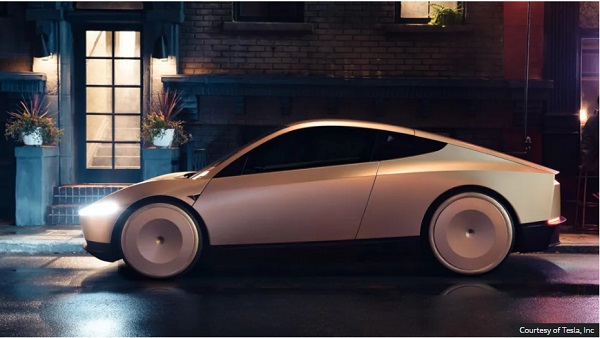
We’ll have to wait and see what unfolds next month during the Tesla Cybercab reveal. If it parallels the Cybertruck reveal in 2019, you might want to set a reminder for at least three years from now to find out if the vehicle is ready for mainstream use.
Recently, Tesla CEO Elon Musk appears to be losing interest in the automobile industry. He argues that the future of Tesla does not depend on selling more vehicles, but rather on advancements in artificial intelligence and robotics. A key element of that vision involves self-driving cars that can serve as “robotaxis,” which would eliminate the need for human drivers entirely.
However, Musk seems unwilling to rely on ordinary Model 3 sedans and Model Y SUVs for his version of an Uber competitor. Tesla claims it is creating a vehicle specifically designed as a robotaxi, which Musk suggested might be named the “Cybercab” during a recent earnings call.
This is an extraordinarily ambitious initiative, one that represents the ultimate evolution of Tesla’s long-term reliance on its Autopilot and so-called Full Self-Driving systems. It is also highly untested, depends on aggressive development of entirely new technologies, relies on uncertain consumer acceptance, faces regulatory hurdles that have yet to be established, and will require Autopilot and FSD to navigate a complicated legal landscape, including a federal criminal investigation.
In essence, this could be Musk’s boldest and riskiest move up to this point—and it remains far from guaranteed. Nevertheless, let’s examine what we think we know so far, based on the company’s various statements and concept artwork that have surfaced.
What do we understand about the Tesla Robotaxi?
For at least ten years, Musk has consistently claimed that self-driving capabilities would soon arrive in Teslas. He has stated over the years that autonomous Teslas could generate considerable passive income for their owners by transporting passengers while parked. None of this has yet materialized.
In more recent years, Tesla executives have also begun discussing the concept of a vehicle specifically designed for the purpose of being a robotaxi. This means not just a standard Tesla that can drive autonomously at times, but a vehicle engineered from the ground up with that sole aim.
The robotaxi initiative has taken priority over more traditional—and arguably, wiser—projects at Tesla. In April, Reuters reported that Tesla had abandoned plans for an affordable mass-market vehicle, informally referred to as the Model 2, to focus entirely on the robotaxi. (Musk has suggested that this less expensive model is still a possibility, but it doesn’t appear to be a priority.)
When Will Tesla Unveil the Robotaxi?
In April, Musk mentioned in a post on X that Tesla would present the robotaxi on August 8. However, in July, Bloomberg stated that Tesla intended to delay the event until October. The outlet explained that Tesla teams required more time to create additional robotaxi prototypes.
During Tesla’s Q2 2024 earnings call, CEO Elon Musk confirmed that the Robotaxi reveal would take place on October 10th.
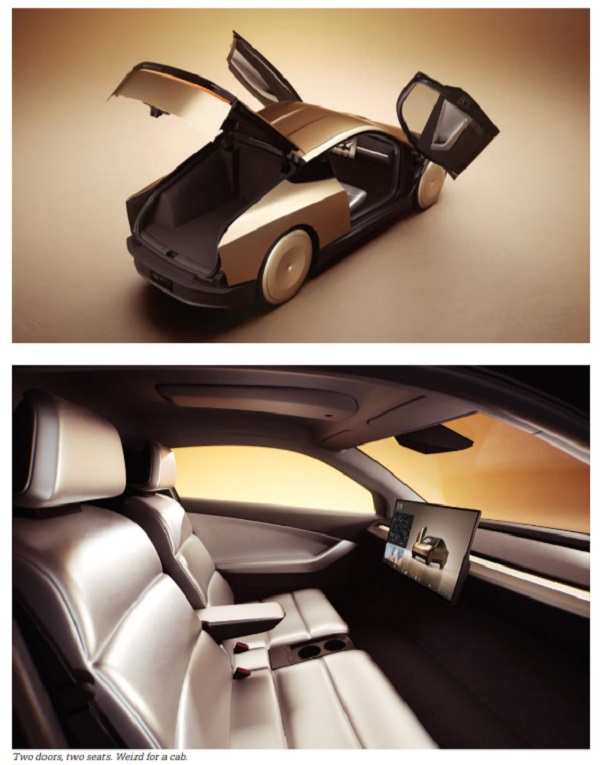
When Is the Robotaxi Expected to Be Released?
Up until now, Tesla has not succeeded in achieving fully autonomous driving in its existing vehicles. It markets a feature called “Full Self-Driving,” but this system still necessitates driver oversight and is quite far from being perfect.
Before introducing robotaxis without steering wheels, Tesla must produce reliable self-driving technology, and it’s uncertain when or if that will occur.
In response to an investor query on Tesla’s Q2 2024 earnings call, Musk explained that the company couldn’t begin offering rides to customers until Full Self-Driving could operate without supervision. In its earnings report released on Tuesday, Tesla stated that the “timing of Robotaxi deployment is contingent on technological progress and regulatory permission.”
The robotaxi’s unveiling this evening does not necessarily indicate that it is nearing production. Tesla unveiled the Cybertruck pickup in late 2019, but customers did not receive their trucks until five years later. The design for an upcoming supercar, the Tesla Roadster, was revealed in 2017 and is still yet to be launched.
What Will the Robotaxi Look Like?
Now that it has been revealed, we know precisely its appearance. However, prior to its debut, we had a general idea of what to expect. In 2022, Musk indicated that the robotaxi would forgo a steering wheel and pedals, describing its design as “futuristic.” Walter Isaacson, Musk’s biographer, noted that an early concept for the vehicle displayed a “Cybertruck futuristic feel.” This could suggest a more angular, polygonal design compared to the sleek Model 3 and Model Y.
He provided an illustration in his book, Elon Musk, showcasing a compact, two-seat vehicle with a teardrop silhouette. In April, Musk referred to the robotaxi as the Cybercab. It remains unclear if this will be the actual name, but it would be logical given its reportedly Cybertruck-inspired styling.
In a video shared on X, Tesla released additional teasers. The clip features what might be the robotaxi’s front bumper and white interior.
Previously, Tesla has indicated it would construct the robotaxi using its lower-cost, next-generation vehicle framework. Recently, however, Tesla announced it is expediting new vehicle initiatives by employing a blend of its current and next-generation technologies. It remains uncertain which technology will support the robotaxi.
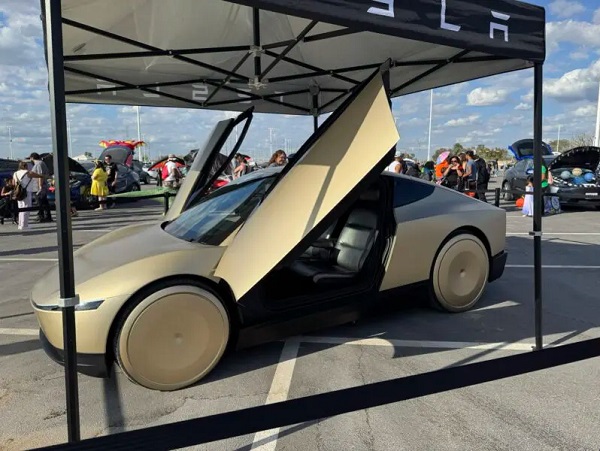
How Will Tesla’s Competitor to Uber Function?
During an earnings call, Musk described Tesla’s taxi service as a blend of Airbnb and Uber. The concept is that Tesla’s fleet will consist of both its own robotaxis and vehicles from Tesla owners who decide to participate—meaning you own the car and when you’re not using it, you can “rent” it out for robotaxi service.
This is a promise Musk has made over the years in different forms. Back in 2019, he stated that by 2020, up to a million Model 3s on U.S. roads would be available as fully autonomous (SAE Level 5) robotaxis. As you may have noticed, that did not materialize.
Nonetheless, Tesla is evidently heading in that direction. In its earnings report, the automaker displayed some renderings of what its Tesla ride-hailing app might resemble.
How Does Tesla’s Robotaxi Differ from Waymo, Cruise, and Zoox?
Waymo and Cruise, autonomous taxi services owned by Alphabet and General Motors, respectively, utilize modified versions of standard electric vehicles for their operations. Waymo employs Jaguar I-Paces, while Cruise works with Chevrolet Bolts.
As they have developed their self-driving technology on public roadways, both companies have utilized safety drivers who can monitor and intervene if necessary. After a pedestrian accident last year, Cruise temporarily halted operations and is gradually reintroducing its vehicles with drivers present.
Zoox, the self-driving startup owned by Amazon, is developing a taxi service utilizing specially designed pod-like vehicles that lack steering wheels. However, it is still in the experimental stage and has not yet commenced commercial operations.
In contrast to other companies, Tesla claims it can achieve dependable self-driving capability using solely cameras. Other autonomous-driving initiatives depend on additional sensors, such as LiDAR units that employ lasers to construct a three-dimensional representation of the environment. Many experts in the field of autonomous vehicles are skeptical that Tesla’s streamlined, vision-only method will succeed.
What Obstacles Are in the Way?
How much time do you have? Primarily, the endeavor hinges on Tesla “solving” the challenge of fully autonomous driving, something that many experts caution could take decades rather than just a few years—if it’s ever achieved at all. Moreover, Tesla historically shuns autonomy technologies that other car manufacturers support, such as LIDAR. Instead, it is attempting to train AI through the use of cameras, sensors, and supercomputers.
Additionally, the United States is not prepared for a large-scale robotaxi network. Although testing and pilot programs for robotaxis are underway in around ten states, no comprehensive federal regulations exist. Issues surrounding accident liability and other concerns need to be addressed first. Furthermore, as previously mentioned, Tesla’s current Full Self-Driving (FSD) and Autopilot systems have faced scrutiny due to high-profile crashes, lawsuits, state investigations, and even a Department of Justice inquiry into whether the company misled investors and consumers about its driver-assistance features.
Why Is the Tesla Robotaxi Important?
Tesla, along with its enthusiastic investors and optimistic Wall Street analysts, believes that autonomous driving will enable the company to generate substantial revenue over time. This belief is part of the reason why Tesla has such a high valuation.
As of now, it is valued at $544 billion, which is roughly ten times the market capitalization of rivals like Ford and General Motors. A functioning robotaxi will be crucial if Tesla aims to meet the expectations set by its inflated stock price.
“The Robotaxi has no plug,” Elon Musk remarked during the event last night. Is Tesla poised to make a significant move toward inductive charging?
Well, the moment has finally arrived. Tesla unveiled its eagerly awaited Robotaxi, as well as a driverless Robovan, during last night’s presentation at the Warner Bros. Discovery studio in Burbank, California.
The event featured the usual Elon Musk speech, interspersed with random audience questions—much like when that engaging substitute teacher comes in trying to make the best of things despite lacking all the details.
The entire reveal offered minimal technical specifics, leaving us unaware of the battery capacity of the Cybercab, its charging speed, maximum speed, or whether it utilizes rear-wheel, front-wheel, or all-wheel drive. Instead, Musk concentrated on an “optimistic” timeframe projecting that the driverless two-door vehicle will be operational “by the end of 2027” and priced under $30,000. Nevertheless, it’s important to remember that the second-generation Tesla Roadster was introduced in 2017 but has yet to enter mass production.
That being said, he did share one minor yet intriguing detail: the Tesla Cybercab will charge wirelessly through inductive charging, rather than through a cable. In fact, according to Musk, it does not even possess a charging port, as he briefly mentioned during the evening’s event.
“Something we’re also doing, and it’s really about time, is inductive charging,” he stated. “So, the robotaxi has no plug. It simply goes over the inductive charger to charge. So, yeah, that’s how it should work. Thanks, everyone. I appreciate your support.”
But this encapsulates everything we know on the subject, which isn’t much. Numerous questions remain unanswered, such as how long recharging takes, the dimensions of the inductive charger, or the cost of acquiring one. These are all pertinent inquiries, especially considering Tesla’s vision of the Cybercab, which is that individuals will have the ability to purchase one—or several—and manage a personal fleet of driverless cabs from their homes. This effectively shifts the responsibility from the company to the individual while also increasing the costs associated with operating such a fleet.
Elon Musk stated that the Cybercab could serve as an excellent option for individuals currently driving for Uber and Lyft. In urban centers, many rideshare drivers already utilize electric vehicles, making them familiar with charging an EV and maintaining it. However, if they need to invest in three inductive chargers for a small fleet of Cybercabs, the upfront costs might exceed expectations.
Additionally, there’s the concern regarding charging speeds. Presently, typical inductive charging solutions generally max out at around 20 kilowatts, which is significantly less than the 250 kW peak rate available at Tesla’s own Superchargers. While there are wireless charging pad prototypes that have achieved 270 kW, they are still years away from being widely available.
So, how would this actually function? If recharging the Cybercab requires an entire night and it’s anticipated to operate throughout the day carrying passengers, it could lead to challenges. Downtime is crucial in the ride-hailing business. Unless Tesla manages to provide a wireless charging pad that is both affordable and capable of delivering sufficient power to extend range quickly, this plan may face difficulties.
Elon Musk, the CEO of Tesla, revealed that the Robotaxi will be available for purchase prior to 2027
Musk unveiled the sleek Robotaxi today at the Warner Bros. Hollywood studio close to Los Angeles. He entered the elegantly designed vehicle featuring butterfly doors, which lacks a steering wheel and pedals, and demonstrated its capabilities by driving it around the Warner Bros. lot.
Musk indicated that consumers would be able to purchase the self-driving cab for less than $30,000—an objective several automakers aspire to with their standard electric vehicles to tackle affordability issues and attract a wider array of car buyers.
This price point is notably lower than the Model 3 sedan currently on the market, which starts at over $42,000 following Tesla’s discontinuation of the base rear-wheel-drive variant due to tariffs on components sourced from China implemented last month.
It’s significant to mention that Tesla has a history of promising inexpensive EVs that turned out to be more costly. For instance, the Cybertruck was initially expected to be priced below $50,000 but now begins at $80,000. Although it’s slated for release in 2026, Musk acknowledged that he often tends to be overly optimistic regarding timelines.
If Tesla can maintain that under-$30,000 price, it could be transformative. However, before that, Tesla must demonstrate that its Robotaxi is safe and can legally operate on U.S. roads.
Various AI and autonomous vehicle experts have expressed to InsideEVs that Tesla’s strategy with its self-driving cars has flaws. Tesla solely relies on cameras and AI for the Robotaxi, while competitors like Waymo employ a more comprehensive mix of sensors, including radar and LIDAR. Moreover, there are still unresolved questions surrounding the Robotaxi’s business model and its operational framework.
We lack detailed information about the platform and how it impacts vehicle pricing, making it unclear how Tesla intends to meet that ambitious price point. However, the automaker has the ability to manufacture at scale and has experience in reducing costs.
Tesla customers might not need to wait until 2026 to experience autonomous driving. The Model 3 and Model Y are expected to receive unsupervised self-driving capabilities in California and Texas by the end of next year, subject to regulatory approval. Eventually, the Cybertruck, Model S, and Model X are also expected to gain this functionality.
The company has stated that the Cybercabs would be the “most affordable” and “cheapest to operate.” According to Musk, the average bus ride costs around a dollar per mile, while the Cybercab would charge 20 cents per mile. Considering taxes, it would likely be around 30-40 cents per mile.
Musk argued that the average car owner drives only about 10 hours a week, despite there being 168 hours in total each week. Thus, he believes that autonomy will allow individuals to save both time and money. Nevertheless, this remains theoretical for now, and it will be interesting to see how it evolves over time.
Elon Musk has introduced the long-anticipated robotaxi, known as the Cybercab, at the Warner Bros Studios in Burbank, California.
The futuristic vehicle, which features two wing-like doors and lacks both pedals and a steering wheel, brought Musk in front of a captivated audience eager to learn more about a project he regards as pivotal to Tesla’s future direction.
During the event titled “We, Robot,” the billionaire reiterated his belief that fully autonomous vehicles will be safer than those driven by humans and could even generate income for their owners by being rented out for rides.
Investors have not yet shared his excitement – Tesla’s stock price dropped after the US markets opened on Friday morning.
At 11:45 Eastern Time (16:45 BST), the value of its shares had decreased by over eight percent, trading at approximately $219.
In contrast, stocks of ride-hailing competitors Uber and Lyft, which also have ambitions in autonomous technology, were each up by as much as 10%.
Doubts are emerging regarding Mr. Musk’s timeline for the production of the Cybercab, projected to start “before 2027,” considering his history of missing deadlines.
“I tend to be overly optimistic with timelines,” he humorously remarked during the event.
He mentioned that the Cybercab – set to compete against rivals like Alphabet’s Waymo – would be priced below $30,000 (£23,000).
However, analysts question the feasibility of that target.
“Tesla will face significant challenges in offering a new vehicle at that price within that timeframe,” stated Paul Miller from Forrester research.
“Without external subsidies or Tesla incurring losses on each vehicle, launching at anything close to that price in this decade doesn’t seem realistic,” he added.
Concerns about safety were also raised.
Mr. Musk predicted that “fully autonomous unsupervised” technology would be available in Tesla’s Model 3 and Model Y in Texas and California next year “wherever regulators grant approval.”
However, such approval is anything but assured.
“It involves a large piece of machinery operating at high speeds on roads, so safety concerns are paramount,” remarked Samitha Samaranayake, an engineering associate professor at Cornell University.
Tesla’s ambitions in self-driving technology depend on cameras less expensive than radar and Lidar (light detection and ranging) sensors, which are the foundation of many competitors’ systems.
By programming its vehicles to navigate autonomously, Tesla intends to utilize artificial intelligence (AI) informed by raw data gathered from its millions of cars.
Yet the research community “is not convinced that Tesla’s approach provides the safety assurances we desire,” said Mr. Samaranayake.
The cybercab initiative has faced delays, having originally been expected to launch in August.
This summer, Mr. Musk mentioned in a post on X, formerly known as Twitter, that the delay was due to design changes he deemed important.
Tesla also appears likely to record its first-ever annual sales decline as competitors enter the electric vehicle market, even as sales have slowed down.
Despite this gloomy backdrop, Tuesday’s event was filled with spectacle, featuring Tesla’s humanoid robots dancing and serving drinks to attendees.
Mr. Musk introduced another prototype for a “Robovan” capable of transporting up to 20 passengers simultaneously.
The stylish shuttle “might become a new transportation mode that Tesla exploits in the future,” suggested Dan Ives, a managing director at Wedbush Securities, who attended the event.
Another analyst noted that the event felt reminiscent of the past while also hinting at future directions.
“Musk adeptly illustrated an ideal future for transportation that aims to save time and boost safety,” commented Jessica Caldwell, head of insights at Edmunds.
However, despite the showmanship, skepticism remains about his ability to realize the vision he presented.
“Numerous questions linger about the practical aspects of achieving this,” Caldwell added.
The progress of robotaxis has faced challenges, as driverless vehicles operated by GM subsidiary Cruise were temporarily halted in San Francisco following an incident involving a pedestrian.
Nonetheless, the sector keeps growing.
Waymo announced earlier in October that it would be adding the Hyundai Ioniq 5 to its robotaxi fleet after these vehicles complete on-road testing with the company’s technology.
Ride-hailing giant Uber also aims to incorporate more autonomous vehicles into its fleet to enhance delivery and ridesharing services for customers.
In August, it announced a multi-year partnership with driverless car developer Cruise.
Chinese tech firm Baidu is reportedly planning to expand its robotaxi division, Apollo Go, outside of China, where the vehicles are operational in multiple cities.
Eight years after pledging a self-driving taxi, Elon Musk has finally introduced the new Tesla Cybercab. It is a fully autonomous vehicle lacking a steering wheel or pedals, and you can purchase one in 2026 for under £23,000 – or so says Elon Musk.
It was revealed at Tesla’s ‘We, Robot’ event in California, alongside a new autonomous Robovan that will be able to transport up to 20 individuals or cargo across cities without a driver at the helm.
New Tesla Cybercab set to launch in 2026 for less than £23,000
The key highlight here is that individuals will have the opportunity to purchase a Tesla Cybercab, contrary to speculation that they would only operate as city-owned fleets. Its price will be below £23,000 ($30,000), and you’ll have the option to rent it out when you’re not using it to earn some extra income.
Tesla’s autonomous taxi initiative extends beyond the Cybercab, as owners of Model 3s and Model Ys will also benefit from full, unsupervised self-driving in Texas and California next year. Musk asserts that these owners will similarly be able to rent their vehicles out, just like the Cybercab.
It’s important to consider these timelines with skepticism. Elon Musk himself acknowledged that he tends to be overly optimistic regarding deadlines, having previously promised a million robotaxis on the road by 2020. He also claimed that a self-driving minibus would be available by 2019, whereas we are only now seeing the first concept.
Naturally, there are several regulatory challenges to address before a car without pedals can gain approval for use in cities worldwide. Therefore, you should expect a wait before seeing a Cybercab navigating around London.
What is the functioning of the Tesla Cybercab?
You can essentially think of it as an Uber experience minus any uncomfortable conversations. You’ll be able to summon one via an app on your phone, and it will transport you to your desired location. During the ride, you can watch movies, work on your laptop, or even take a nap.
The vehicle utilizes a set of cameras and sensors to monitor its surroundings, employing data from countless cars making millions of journeys to enhance its safety over time. This capability relies heavily on Tesla’s artificial intelligence technology rather than solely on hardware, making it cost-effective to manufacture and easy to update.
A novel feature of the Cybercab is its inductive charging capability. There are no plugs to connect, as you’ll drive over a large wireless charging pad, similar to what you might use for your smartphone, to charge the batteries. However, this should be taken cautiously since significant work on infrastructure would be required for practical implementation. A conventional plug is more likely when the vehicle enters production.
Interior of the new Tesla Cybercab
What immediately stands out about the Cybercab’s interior is the absence of a steering wheel or pedals. Tesla typically designs minimalist interiors, but this takes it to an entirely different level.
You’ll find only a large screen in the center, which can be used to watch movies, make video calls, or stream music. Compared to the Verne Robotaxi, it offers a more enclosed experience, as the Verne has a large glass area for expansive views, whereas the Cybercab is designed to create a more isolated atmosphere from the external environment.
Design of the new Tesla Cybercab
Given that this model comes from the same design team responsible for the unconventional Cybertruck, it’s expected to have a very futuristic appearance. And it does.
Its side profile is unlike anything else currently on the road, featuring a smooth, almost teardrop shape that sharply contrasts with the rounder Verne Robotaxi presented by Rimac earlier this year. The gullwing doors add a distinctive touch as well.
The car retains several design elements from the Cybertruck, but without the sharply defined angles. You’ll notice a similar full-width light bar at the front, along with a comparable bare-metal finish to the truck.
Additionally, the rear design reflects more Cybertruck characteristics, with a robust bumper and squared-off back end, and the concealed lights embedded in the bumper also pay homage to that truck design.
New Tesla Robovan has also been announced
In addition to the new Cybercab, Tesla has introduced the Robovan. This futuristic minibus operates on the same concept as the Cybercab, allowing you to summon it via your smartphone, with a capacity to accommodate up to 20 passengers.
The Robovan can also function as a cargo transport across urban areas, and its design is truly wild. Elon Musk stated that this is the design we can expect in production, and given the Cybertruck, we have every reason to believe this.
The triple light bars positioned at both the front and rear are unlike anything we’ve seen from Tesla previously, and this van breaks new ground by having no windscreen. The interior features comfortable seats that face one another, and it’s a safe bet that there will be numerous screens to entertain all passengers during their journey.
While the Tesla Robotaxi was the standout feature of Thursday night’s reveal event, the company led by Elon Musk elevated its vision of an autonomous future even further with the unveiling of the Robovan concept.
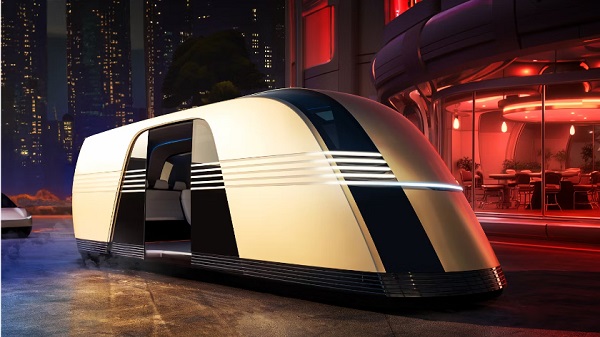
Robovan or Robobus?
“We’re going to manufacture this, and it will resemble that,” Musk told a group of exclusive invitees. The Robovan might include “van” in its name, but the massive vehicle, shaped like a toaster, appears much more akin to a bus or train car. Its art-deco style clearly evokes comparisons to classic locomotives, except the Robovan will utilize automated driving.
Similar to the Robotaxi, the Robovan is devoid of a steering wheel or pedals. Indeed, the entire interior resembles a waiting room at a dental clinic, albeit one with inviting ambient lighting. The images that Tesla shared reveal a Robovan setup for passenger transport (Musk indicated it can hold 20 people as well as be used for carrying merchandise).
There are several rows of seats that face each other, featuring large displays mounted on the walls at both ends of the cabin. One side of the Robovan is equipped with a sliding door, partly made of glass, and two glass panel vanes extend along either side of the roof.
Although we now have our first look at the Tesla Robovan, our knowledge beyond visual features and some mostly ambiguous remarks from Musk is still limited. Tesla’s CEO mentioned it could be customized for either personal or commercial purposes, but there was no information on pricing.
Importantly, a timeline for when the Robovan will enter production is not yet available, although a launch in 2027 seems plausible at the earliest, as the smaller Robotaxi isn’t expected to start production until sometime in 2026. That timeline is based on Musk’s statements, who is known for being overly optimistic about launch dates, as he acknowledged during Thursday’s event, saying, “I tend to be a little optimistic with time frames.” Naturally, Tesla must also secure regulatory approval for an unsupervised version of its Full Self-Driving (FSD) software, which will influence the future of the Robotaxi, the Robovan, and the company’s other fully autonomous vehicle initiatives.
Despite reaching impressive expectations, the unveiling of the Cybercab fell flat due to exaggerated claims and limited self-driving capabilities.
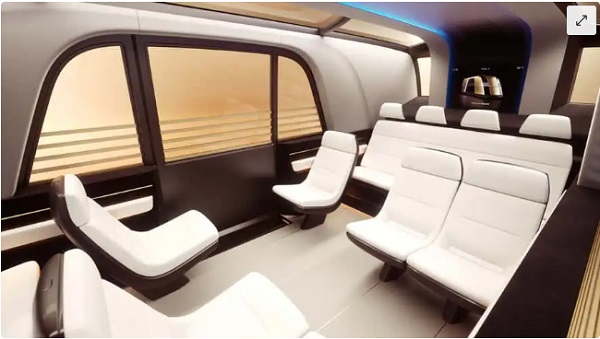
The recent launch of Tesla’s highly awaited Cybercab has ignited significant conversations within the auto industry, impacting much more than just electric vehicles. Initially seen as a revolutionary leap for urban transportation, hopes soared due to months of enthusiastic marketing by Tesla, painting a vision of fully autonomous vehicles transforming city life. However, the event left many feeling dissatisfied as reality did not meet the high expectations, causing a dip in Tesla’s stock price—though it has since recovered due to positive sales predictions.
So, what went wrong? A primary factor was the immense buzz surrounding the reveal. Teaser videos, enigmatic social media updates, and ambitious assertions about advanced technology heightened the anticipation. Tesla aimed to revolutionize urban transport, presenting the Cybercab as more than merely another electric vehicle—it was meant to be the future of ride-hailing and transportation.
When the moment finally came, hopes for a groundbreaking product were met with disillusionment. The design, rather than capturing attention with its sleek, forward-thinking look, was likened to outdated science fiction imagery. The Cybercab’s blocky design and uninspired interior appeared to lack any genuine aesthetic innovation or comfort features. Initial renders suggested elegance and ease, yet the actual reveal felt underwhelming, failing to convince anyone this was the automotive future.
Even more disappointing was the absence of advanced autonomous technology. Fans anticipated that Tesla would fulfill its dream by launching one of the first fully self-driving, commercially viable vehicles. Instead, the Cybercab displayed features similar to those found in many high-end cars today—lane-keeping assistance and adaptive cruise control—while lacking true self-driving functionality. By not delivering on its automation promises, Tesla has set itself apart from rivals like Waymo, who are viewed as closer to achieving fully autonomous vehicles.
This technological inadequacy was glaringly perceived in financial markets. Investors reacted adversely to the announcement, as it underscored the disparity between expected advancements and the vehicle’s genuine capabilities. While CEO Elon Musk asserted Tesla was only years away from achieving full autonomy, many people now view this timeline as overly optimistic. With regulatory approval for self-driving vehicles requiring extensive testing and proof of safety, Tesla’s goals seem even less attainable.
Another lingering concern is the expected pricing structure of the Cybercab. With hopes for affordability, analysts were surprised by its features, which rendered the vehicle more similar to high-priced luxury items. The absence of a steering wheel or pedals raised questions about how the Cybercab’s pricing model would compete with more economical options like the forthcoming ‘Model 2’. This discrepancy presents considerable challenges, especially as the broader electric vehicle market copes with its pricing issues.
The crucial question is: does the Cybercab truly address the needs and desires of urban markets? Critics argue it resembles more of an extravagant tech gadget than a solution to urgent urban transportation problems—such as reducing traffic congestion or offering practical, affordable alternatives for underserved city inhabitants. The reveal suggested that the Cybercab was aimed more at technology elites than at resolving real-life urban transport issues.
In summary, the market reaction highlights the potential risks of excessively promoting products before they are ready. While the idea of electrified, self-driving urban transport vehicles is undeniably fascinating, the Cybercab reveal has made it evident just how far Tesla still has to go to achieve this goal effectively. The disconnect between public enthusiasm and product capability serves as both a cautionary tale and a learning experience for Tesla and the broader automotive sector as they navigate this dynamic and ever-evolving technological landscape.
Elon Musk, the leader of the American electric vehicle and clean energy company Tesla, is known for making bold statements and promising innovative futures. At the recent “We, Robot” event, Musk showcased a line of electric robotaxis for the company, including the Cybercab.
However, despite the presentation’s flashy nature, filled with futuristic designs and staged sci-fi battles, several critical points were overlooked. What other details did you miss during the presentation apart from the shiny robots and grand promises?

Timeline troubles: Why the Cybercab launch is still uncertain
Their suggestion for Musk to introduce a sub-$30,000 Cybercab devoid of a steering wheel or pedals seems promising, but the timing of its release remains unclear: Musk initially indicated that production would commence in 2026 and later revised it to before 2027, acknowledging that he had set overly ambitious targets in past years. If that’s true, it implies that Tesla has missed this target, particularly concerning its robotaxi initiative.
Back in 2019, Musk confidently asserted that fully self-driving robotaxis would be operational by 2020. Fast forward to now, and while advancements have been made, completely unsupervised autonomous vehicles have yet to emerge. Such fluctuations in timelines erode the confidence that investors and consumers place in the Cybercab being functional when expected. Even the most dedicated of Musk’s supporters can no longer overlook the evident production issues, which threaten the credibility of his new vision.
Regulatory challenges: What obstacles is Tesla facing in this venture?
As Musk envisions a future with the vehicle taking full control, regulation becomes one of the major challenges for Tesla’s robotaxi aspirations. Numerous US states and various international countries have stringent legal frameworks surrounding AV technology, particularly vehicles lacking traditional components like steering wheels and pedals.
It seems rather bold, if not impractical, for Tesla to aim for a fully driverless vehicle by 2026 and to suggest starting tests in California and Texas. These regulatory challenges were downplayed during the presentation. There was no mention of the extensive testing, safety certifications, and legal compliance that Tesla will encounter.
Musk also omitted any discussion about investigations into Tesla’s Full Self-Driving (FSD), which has been linked to several accidents. Thus, the path to securing approvals could take significantly longer than Musk’s predicted timeline.
Safety concerns and technology: Are they overhyping the features of the Cybercab?
Undoubtedly, the most evident and perhaps significant concern during the Tesla presentation revolved around safety. Musk claimed that self-driving vehicles would be “10, 20, 30 times safer than humans,” referencing data from millions of miles driven by Tesla.
However, the presentation lacked crucial details on how Tesla plans to mitigate accidents, especially in light of recent FSD concerns. What Musk presented as Tesla’s edge – utilizing artificial intelligence and cameras instead of expensive lidar – has sparked considerable debate.
Lidar, which employs lasers to map the surroundings of the vehicle, is deemed much more reliable for fully autonomous cars. By neglecting this technology, Tesla leans on its camera-based approach, a choice many analysts consider unwise and premature.
Additionally, Tesla’s Full Self-Driving system has encountered regulatory challenges and ongoing complaints. Some accidents, including fatal incidents, have been attributed to the autopilot and FSD systems.
Regulatory bodies are still investigating whether Tesla is sufficiently preventing driver distractions while users engage with the car’s semi-autonomous systems. However, there was no mention of these concerns in Musk’s presentation, leaving many to question just how secure the future of robotaxis will truly be.
Is Tesla’s vision realistic, or just another hype?
Elon Musk excels in public relations and has a knack for making people believe in the future of self-driving vehicles and robots. Nonetheless, when it comes to Tesla’s robotaxi project, the presentation fell short of impressive. Several critical factors, including the production timeline, regulatory hurdles, safety issues, and business model, play a significant role.
As a result, many investors and analysts remain doubtful. While it’s easy to get caught up in the concept of affordable robotaxis, actualizing this vision is far more challenging. Unless these hurdles are addressed, the Tesla robotaxi may remain more of a promotional concept than a tangible product, at least for the time being.
The future Musk envisions may be incredible, but achieving it will require more than just flash and appeal. The robotaxi transformation may not be far away, but it will still take time before it becomes a reality, particularly until safer technologies are developed and regulations governing these vehicles are clarified.
Musk expressed during the analyst call that he is “confident” Cybercabs will achieve volume production by 2026.
“I am confident that Cybercab will reach volume production in ’26, not just begin production, but achieve volume production in ’26,” he mentioned.
The company must obtain regulatory approval for the Cybercab’s operation, and Musk anticipates receiving this approval next year in Texas and California, which would also enable the launch of its ride-hailing application. In discussing Tesla’s vehicle sector, Musk projected a 20% to 30% increase in vehicle sales next year “despite negative external factors.”
Tesla aims to manufacture at least 2 million Cybercabs annually
Musk stated in the call that Tesla intends to produce a “significant” number of robotaxis each year
The Tesla CEO noted, “We’re targeting at least 2 million units a year of Cybercab. This will occur in more than one factory, but I believe it’s at a minimum of 2 million units yearly, potentially up to 4 million in the end.”
Musk tempered his statement, referring to these figures as his “best estimates.”
Musk indicated that the Cybercab will be priced at “approximately $25,000.”
When Musk initially unveiled the Cybercab at the “We, Robot” event, he mentioned that the company projected a selling price of “below $30,000.”
During Wednesday’s earnings call, Musk revised that to a cost of “approximately $25,000.” “What we’ve designed is optimized for autonomy,” Musk said. “It will cost around 25K, so it is a 25K vehicle. And you can, you will be able to purchase one exclusively if you wish. It simply won’t include steering wheels and pedals.”
Tesla will not offer a Cybercab variant featuring a steering wheel or pedals.
If you were expecting a more conventional sub-$30,000 Tesla model with a steering wheel and pedals, the Cybercab will not have that.
“So, I believe we’ve made it clear that we — the future is autonomous,” Musk said when asked about the timeline for a $25,000 non-robotaxi vehicle.
Musk described a regular $25,000 model as “pointless,” asserting that a “hybrid, manual, automatic” vehicle would not be “as good” as an autonomous version. He stated that Tesla is developing a vehicle that is “optimized for autonomy.”
Musk described the experience of riding in the Cybercab as akin to being in “a personal movie theater.”
Musk indicated that Tesla will continue to enhance the offerings on Tesla car displays, and once full autonomy is achieved, “you can do anything you want” while in the vehicle because it will be self-driving.
He provided examples such as browsing the internet, interacting with AI, watching films, playing video games, or engaging in some “productive tasks.”
“So that’s why the Cybercab features a large screen and a quality sound system so you can watch a great movie,” Musk explained.
Musk described the machine creating the Cybercab as “revolutionary.”
He said Tesla is “designing a lot of high volume production,” as well as the “machine that builds the machine,” which he labeled as “revolutionary.”
“It’s not merely a groundbreaking vehicle design, but also a revolution in vehicle manufacturing accompanying the Cybercab,” Musk stated. “The cycle time, like, the units per hour of the Cybercab production line is — this is truly something exceptional.”
Musk mentioned that the machine constructing the machine is designed to be five times more efficient than a conventional factory regarding cycle time.
Tesla asserted that it has effectively combined factors such as who will manufacture the vehicle, its production location, shipping methods, and assembly processes to create “the most efficient factory possible.” This will be evident in Tesla’s capital expenditure efficiency once implemented, in addition to the selection of parts and overall performance, as highlighted by the company during the call.
